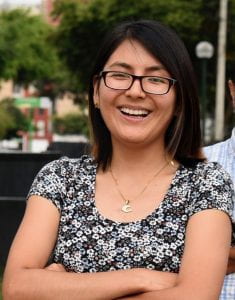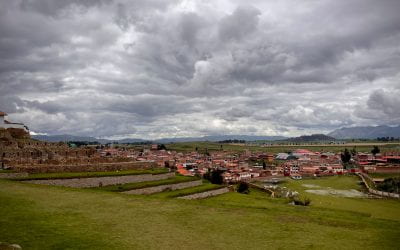
About the Author
Madai Urteaga Quispe is a Ph.D. candidate in Harvard’s Government Department in the field of Comparative Politics. Her dissertation focuses on the political economy of agricultural policies in Latin America and explains why countries vary in the level and type of support they provide to agriculture while industrializing in the 20th century. Her research interests also include state-building trajectories in the developing world. She is a Graduate Student Associate at the David Rockefeller Center for Latin American Studies (DRCLAS) and the Weatherhead Center for International Affairs (WCFIA).
The Neglected Sector
Agriculture in Peru
As a Peruvian student who grew up in a country that praises itself for its diversity of agricultural production and where more than a quarter of the population works in agriculture (27%), I was surprised to learn about how little the government does for its farmers. After digging a little bit on history, it turns out that agriculture in the country has been neglected by the state for at least 50 years. Covid-19 only make salient the stagnation of the sector. Small scale producers struggled to transport their products from the fields to the market, hardly aided by the poor transportation infrastructure. A drop in demand following the closure of markets led to decreases in prices. Many farmers sold their produce below production costs. As a result, farmers saw their incomes dropping. Despite their key role to feed the cities during the pandemic, agricultural producers only got two compensatory measures: a one-time income support bonus and subsidized credit for 2020-21. The latter program failed during implementation (only 2% of the funds have been allocated in credit). Why has agriculture been neglected by the state for so long? Why does the government pay little attention to its farmers?
Land reform was not enough
To someone informed about Peruvian history, the neglect of agricultural producers may seem puzzling. Peru was the country where the military government (1968-1975), led by Colonel Juan Velasco Alvarado, implemented one of the most aggressive land reforms that expropriated landlords to the benefit of landless peasants. As Ashutosh Varshney, the author of Democracy, Development, and the Countryside, summarizes, from an economic point of view, land reform is often considered as a tool to improve agricultural productivity: smaller units will produce more efficiently than large landholdings because labor will be more intensively used in the latter than in the former. No wonder why, according to the Cristobal Kay, author of the article “Why East Asia Overtook Latin America”, the East Asian developmental states implemented land reforms to modernize agricultural production. Beyond improving peasants’ welfare, land reform should have boosted agricultural output.
Land reform failed in making agriculture more productive. The main reason, I believe, is that the government did not invest in policies to provide farmers with inputs to modernize agricultural production. Unlike countries such as Korea or Taiwan where land reform was accompanied with aggressive policy packages to promote agricultural output (e.g. investments in irrigation, credit, technology, improved seeds, support prices), in Peru, as Elena Alvarez, claimed in her book Economic Policy and Agriculture in Peru 1969-1979 (original in Spanish), the military government mistakenly assumed that land reform would bring agricultural modernization by default. The military government broader economic policies to promote import substituting industrialization penalized agriculture through controlled prices of food crops, taxes on export crops, and appreciated exchange rates. These policies depressed farmer’s incentives to produce rather than the opposite.
Did the neoliberal reforms implemented in the early 1990s benefit producers? The removal of distortions to agricultural markets (e.g. freeing the exchange rates and prices) and trade liberalization (e.g. reduction of tariffs and/or quotas) arguably benefited producers. The benefits, however, are heterogenous. Agro-exporters of non-traditional products such as fruits and vegetables were the most benefited from trade liberalization–hence the international praise of the Peruvian agro-exports boom—whereas producers of import competing crops such as wheat, maize and rice or staples such potatoes, struggled. Unlike advanced economies or even neighboring Colombia, that protect farmers through tariffs and/or market price support, in Peru producers are only weakly protected. According to the Producer Support Estimate calculated by the International Development Bank (IDB), as of 2010, policy measures in Peru only increased farmers income by 4.63% versus the level they would obtain without those policies, whereas in Colombia, they did so by 20.34%. In 2018, Colombia was still ahead of Peru: 14.4% versus 8%.
Of course, I do not want to belittle the Peruvian governments’ continuous investment in irrigation infrastructure (both before and after the neoliberal reforms) or phytosanitary institutions since the 1990s. As the IDB states in a recent book Trading promises for results: What global integration can do for Latin America and the Caribbean: “the fruit and vegetable boom in Peru would not have been possible without massive public irrigation projects enabling farmers to produce in what was essentially a dessert”. However, these benefits accrue mostly to large-scale producers of export crops located in the Coast of the country. The rest of domestic market producers are sidelined. Peasants got land when Velasco came to power, but hardly were they given the tools to become successful producers both before and after the neoliberal reforms. The same report by the IDB claims that “Traditional agriculture in the Andean regions, for all practical purposes an entirely different sector, has participated negligibly in the boom.”

Agricultural Workers in Peru. Credit: Center for Tropical Agriculture
Why domestic market producers are neglected
A key feature of Peruvian producers in comparative perspective is their weak levels of organization. Unlike Colombian producers that are organized both at the commodity level and at the sectoral level, and the former are connected to the latter (e.g. commodity level associations have membership in the sectoral association), in Peru, producers are highly fragmented and lack a sectoral association to represent their interests. Not all producers are organized, producers of a single commodity are often represented by competing associations, and there is no association integrating both agro-exporters and producers for the domestic market. The National Convention for Agricultural Producers, CONVEAGRO, falls short of being an encompassing association—it only groups small-scale producers, not agro-exporters. They latter rather belong to exporters’ associations. The commodity level associations are not integrated into CONVEAGRO. Added to that, commodity level associations are relatively new. Most of them were founded in the 1990s. Unlike in Colombia and Chile where encompassing agricultural organizations survived, in Peru the large-scale producers’ associations, the National Agricultural Society disappeared when the military government dismantled it. Since Peruvian farmers are poorly organized, their demands are unlikely to have an echo in the government.
Organizational weakness, I believe, helps to explain why Peruvian producers have fallen short of securing support from the government in critical events. One of these events was the negotiation of Free Trade Agreement with the United States. My dissertation research on the political determinants of agricultural policies in Latin America, carried out since 2019, documented that farmers producing for the domestic market mobilized in opposition to the trade agreement, but there was not a single interlocutor to represent their demands, commodity associations did not coordinate their demands with CONVEAGRO, and they did not have the support of agro-exporters, nor of other actors in the business community. The Ministry of Agriculture hardly had a voice in the negotiation team, neither were producers’ associations coordinating with the agency, as it is typical in other countries where farmers oppose trade liberalization. The government took advantage of this weakness and promised compensation only to the most vocal opponents. The compensatory policies only included three crops—maize, wheat and cotton—providing income support but not investments in promotional policies to boost agricultural output. Farmers lacked institutionalized representation in the boards designing or implementing the policies. In a report about the Peruvian Trade Liberalization sponsored by the IDB, Hernan Tello claims that producers were never compensate. In fact, in 2020, Congress passed a law in 2020 to make compensation effective after 12 years when the original compensation was supposed to have taken place!
This outcome contrasts heavily to what Colombian farmers got when the government signed a Free Trade Agreement with the United States. Better organized, they not only had a single voice during the negotiations and coordinated with the Ministry of Agriculture, but also got the backing of other business associations. The compensation package for Colombian farmers was more comprehensive and generous: More crops covered, both income support and promotional support, both agro-exporters and domestic producers would be eligible to receive the benefits, and they had institutional representation. The Peruvian government budgeted $164 million for the whole program; the Colombian government budgeted $100 million annually.
The origins of organizational strength (or weakness)
Accounting for why farmers are better organized in some countries and not in others would require a full-fledged theory, and indeed I intend to come up with that theory. As I work on it, one idea follows. From a historical perspective, the state has played a key role helping agricultural associations to develop. On his famous book Markets and States in Tropical Africa, Robert Bates claimed that collective action costs are higher to overcome in agriculture because a large number of producers are dispersed across the territory. Thus, they must be provided with a steady flow of resources to offer selective incentives for membership or the associations are likely to be short lived. The state can step in to providing resources to offer selective incentives. When support is continuous, it is likely to contribute to organizational building.
Several examples illustrate this association. The Colombian government had a budget item to support agricultural associations since the 1940s and delegated quasi-public functions such as administration of funds for agricultural research and marketing to them since the early 1960s. The most known example is that of coffee. As an anecdote about how far the support coffee dates back to, just think of Juan Valdez, the coffee brand that the Federation of Coffee Producers, subsidized by the government and empowered with semi-public functions, developed in 1959. These arrangements are hardly unique to Colombia. In Japan, the government provided cooperatives with quasi-public functions which enabled them to monopolize financial and marketing assistance to farmers. In Turkey, since 1962, the state has supported agricultural cooperatives through diverse policies. In Peru, the government support for associations was short-lived. The military government promoted the formation of cooperatives to administer production in reformed land, but they failed to continue its support. A few years after they were created, they were dismantled by the same associates, in some cases out of administrative issues and lack of support from state agencies.
A glimpse of hope?
Given the weak organization of Peruvian farmers and the general government neglect of the sector, both form neoliberal and moderate administrations, I documented in my research, I was resigned to see continuity. However, unlike previous administrations, the newly elected left-wing government of Pedro Castillo campaigned on improving agriculture. One of his innovative proposals was substitution of agricultural imports to reach food security with a focus on the sidelined small-scale producers. Agro-exporters, he claimed, were disproportionally getting the policy benefits, whereas producers for the domestic market have been marginalized. Less innovative proposals are improved transportation to help farmers to sell their produce and irrigation and investment in technology. For these proposals to be more than “cheap talk,”,farmers will need to come together and have the backing of the other actors in society. The culinary industry may be one potential ally given that they are important consumers of local produce and has more influence in the public sphere than farmers do. With my research, I hope to undercover the most conducive conditions to farmers’ organization and coalition formation that may help producers to finally push the government to deliver on its promises.
More Student Views
Resilience of the Human Spirit: Seizing Every Moment
In the heart of Chicago, where I grew up, amidst the towering shadows of adversity, the lingering shadows of generational demons and the aroma of temptation, the key to the gateway of resilience and determination was inherited. The streets of my childhood neighborhood became, for many, prisons of poverty, plundering, crime and poor opportunity.
Andean Cultural Landscapes in Danger: The Chinchero International Airport
English + Español
Cusco stands as one of the most culturally and ecologically captivating regions globally.
Blossoming Bonds: Beauty and Belonging in Mexico
When I heard the news about my upcoming trip to Mexico, a surge of excitement coursed through me, and I immediately felt the urge to share this exhilarating news with my close friends and family.



